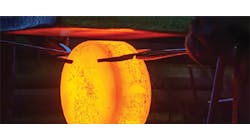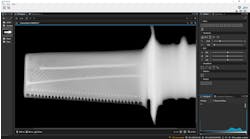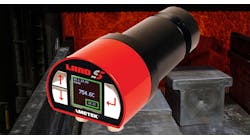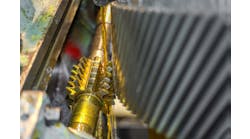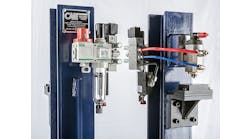... At first it appeared to be handling damage, but that has not proved to be the cause. It is almost certain that the pits were created during forging. Many gears will clean up in the final grind, but some pits remain even after the finishing operation, which removes 0.008/0.010 per flank, causing problems for the end user. The remaining pits have the tendency to cause galling during operation. (The writer attached a series of photos of the problem forgings with the question.) All parts have been cleaned and sized, so original pit geometry has been altered slightly, but the shape and depth is similar to that in the rough forged state. Some of the pits appear as if they have a smooth surface and a definite shape. We have run the gamut of possible causes for these pits, from material inclusions, dirty billets, and die build-up, to contamination in the lube. Nothing we have thought of seems to be able to cause what we see in these forgings. The pitting has happened twice, that we recall. Any light you may shed on this situation would be appreciated.
A: In the photos of the spur gears you submitted, three of the four pits illustrated seem to have somewhat shiny bottoms. This suggests to me that some metallic particles are getting into your dies, or possibly during the lube cycle.
When you state the pits are located in a vertical plane, I assume you mean radial from the axis of the gear centerline. From this observation, I gather you are using a radial forming process.
Have you tried taking closer pictures, say at 15 X or so? This would help determine if the defects are indeed shiny on the bottoms as they appear in your photos.
You could look at the pits with a Brinell scope that has a magnifying lens. I believe the magnification is about 8X. Focus on the base of the defects by twisting the focus lens.
The defects may be traceable to contamination from fine chips that are probably metallic.
Do you EDM the dies? Or, are they hard metal cut with ultra-high speed spindles, which is becoming more common these days?
If you use EDM, you should be aware that the metallic particles that come from EDM are much finer than from the machining operations. You might want to check your electrodes after they are machined. Any metallic chips there from tooling or from the surrounding areas could be carrying into the EDM operation and causing some arc burns. I have seen this effect a couple of times and it can result in die steel particles that are mechanically attached to the die surfaces. If so, this could account for the problems you are experiencing. You can inspect the graphite electrodes with a magnet to see if any chips are present before they are used.
If you are using high-speed machining, the chips produced are often magnetic and stick to the die surfaces even after air blow-off. Perhaps you need to de-magnetize the inserts or punches. Air blow off will not remove very fine particles that are adhering to a magnetic surface.
Remember too that the very process of forging with induction heaters tends to leave some magnetism on the billets that does not show up until the billets cool down after forging. This magnetizing effect can transfer to the dies over time, so an occasional de-mag might be useful.
For more than 40 years H. James Henning held key technical positions in the forging industry, including as director of technology for the Forging Industry Association, and as president of Henning Education Services, a Columbus, OH, firm specializing in customized education and training in forging technologies.
Guidelines and recommendations offered in this column are based on information believed to be reliable and are supplied in good faith but without guarantee. Operational conditions that exist in individual plants and facilities vary widely. Users of this information should adapt it, and always exercise independent discretion in establishing plant or facility operating practice.
